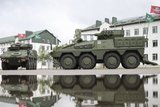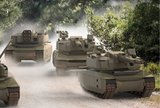ADVS withdraws from Ground Combat Vehicle program competition
Advanced Defense Vehicle Systems (ADVS) has recently decided to withdraw as a competitor for the Army's Ground Combat Vehicle (GCV) Program. The GCV Program is the Army's initiative to develop an armored vehicle that will improve survivability and increase fighting capability beyond that of the current arsenal. Under the current program, the contracting efforts have been divided into three stages. The first stage will not require producing a prototype demonstration vehicle and, in fact, the Army will wait a total of seven years to field a weapon system.
After reviewing the Army's continuing GCV strategy, ADVS has decided to withdraw from the competition. According to ADVS' CEO, James LeBlanc, Sr., "This drawn-out Army process does not fit with ADVS' rapid development and fielding capabilities." For the initial development stage, the Army is willing to spend up to $450 million per contract awarded; which could total up to $1.35 billion. ADVS has shown with similar combat armored vehicles for foreign military use and with other major weapon system contracts that they can design, develop, integrate, prototype and field such an advanced system in one to two years. ADVS focuses on survivable vehicles that meet customer requirements to rigid specifications at a reasonable development cost, to be fielded rapidly and to protect the soldiers today and in the future. Just recently, ADVS delivered the first production of the ADVS 6x6x6 Desert Chameleon armored personnel carriers to the Kuwait Ministry of Interior (KMOI). ADVS began discussions with the KMOI in 2007 to design a security vehicle that is able to meet their specific mobility, survivability, and performance requirements and customer budget. ADVS designed, manufactured, tested, and completed the vehicles for delivery by fall 2010, a less-than three-year full development to production timeline duration.
While ADVS supports the Army's concept, they encourage the US Department of Defense to review the ADVS strategies and past performance and consider ways of developing and fielding vehicles quicker and more economically. Such a rapid process is counter to the current GCV strategy; though supportive of the philosophy of Secretary of Defense, Robert Gates.
Source: ADVS
More from Land Warfare
-
![Hungary set to begin using Hero 400 loitering munitions]()
Hungary set to begin using Hero 400 loitering munitions
Developed by Israel's Uvision and with systems being sold in the thousands to multiple European NATO countries and the US, the Hero family of loitering systems is also in production in the US and Italy, the latter through Rheinmetall.
-
![Croatia orders Leopards and CAESAR howitzers as Lithuania orders more CAESARs]()
Croatia orders Leopards and CAESAR howitzers as Lithuania orders more CAESARs
The Leopard is becoming the tank of choice in central and eastern Europe as Croatia joins Lithuania, the Czech Republic and Hungary in ordering the platform. Lithuania and Croatia have also signed for CAESAR howitzers.
-
![Light Reconnaissance Strike – enabling a vital mission set (Studio)]()
Light Reconnaissance Strike – enabling a vital mission set (Studio)
A new system-of-systems concept will unlock digital integration of sensors and weapons for Light Forces, allowing them to shape the battlefield environment on their own terms and upgrade legacy platforms.






















